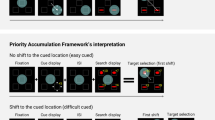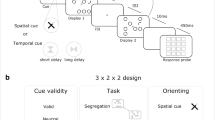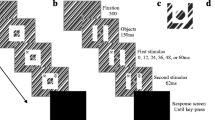Summary
The relative functional significance of attention shifts and attentional zooming for the coding of stimulus position in spatial compatibility tasks is demonstrated by proposing and testing experimentally a tentative explanation of the absence of a Simon effect in Experiment 3 of Umiltà and Liotti (1987). It is assumed that the neutral point of the spatial frame of reference for coding spatial position is at the position where attention is focussed immediately before exposition of the stimulus pattern. If a stimulus pattern is exposed to the right or the left of this position a spatial compatibility effect can be observed when the stimulus-response pairing is incompatible. Generalizing from this, one can say that a spatial compatibility effect will be observed if the last step in attentional focussing of the stimulus attribute specifying the response is a horizontal or a vertical attention shift. If the last step in focussing is attentional zooming (change in the representational level attended to), the stimulus pattern is localized at the horizontal and the vertical positions where the last attention shift had positioned the focus. In this case the spatial code is neutral on these dimensions and so no spatial compatibility effect should result. To test this model we conducted two experiments. Experiment 1 replicated the finding of Umiltà and Liotti that there is no Simon effect in the condition with no delay between a positional cue (two small boxes on the left or right of a fixation cross) and the imperative stimulus, whereas in the condition with a delay of 500 ms a Simon effect was observed. In a comparison condition with a single, rather large cue instead of two small boxes (forcing attention to zoom in), no Simon effect was observed under either delay condition. Experiment 2 used a spatial compatibility task proper with the same experimental conditions as Experiment 1. But in contrast to those of Experiment 1, the results show strong compatibility effects in all cue and delay conditions. The absence of a Simon effect in some experimental conditions in Experiment 1 and the presence of a spatial compatibility effect proper in all conditions in Experiment 2 are consistently accounted for with the proposed attentional explanation of spatial coding and spatial compatibility effects.
Similar content being viewed by others
References
Allport, A. (1987). Selection for action: Some behavioral and neurophysiological considerations of attention and action. In H. Heuer & A. F. Sanders (Eds.),Perspectives on perception and action (pp. 395–419). Hillsdale, NJ: Erlbaum.
Arend, U., & Wandmacher, J. (1987). On the generality of logical recoding in spatial interference tasks.Acta Psychologica, 65, 193–210.
Bauer, D. W., & Miller, J. (1982). Stimulus-response compatibility and the motor system.Quarterly Journal of Experimental Psychology, 31A, 367–380.
Brebner, J. (1973). S-R compatibility and change in RT with practice.Acta Psychologica, 37, 93–106.
Buchner, A. (1988). Räumliche Aufmerksamkeit: Einwände gegen das Lichtkegelmodell visueller Selektivität.Zeitschrift für Experimentelle und Angewandte Psychologie, 35, 523–545.
Eriksen, C. W., & St James, J. D. (1986). Visual attention within and around the field of focal attention: A zoom lens model.Perception & Psychophysics, 40, 225–240.
Eriksen, C. W., & Webb, J. M. (1989). Shifting of attentional focus within and about a visual display.Perception & Psychophysics, 45, 175–183.
Faber, H. E. L., van der Molen, M. W., Keuss, P. J. G., & Stoffels, E. J. (1986). An OR analysis of the tendency to react toward the stimulus source.Acta Psychologica, 61, 105–115.
Fitts, P. M. (1951). Engineering psychology and equipment design. In S. S. Stevens (Ed.),Handbook of experimental psychology (pp. 1287–1340). New York: Wiley.
Fitts, P. M., & Deininger, R. L. (1954). S-R compatibility. Correspondence among elements within stimulus and response codes.Journal of Experimental Psychology, 48, 483–492.
Fitts, P. M., & Seeger, C. M. (1953). S-R compatibility: Spatial characteristics of stimulus and response codes.Journal of Experimental Psychology, 46, 199–210.
Hedge, A., & Marsh, N. W. A. (1975). The effect of irrelevant spatial correspondence on two-choice response time.Acta Psychologica, 39, 427–439.
Kahneman, D. (1973).Attention and effort. Englewood Cliffs, NJ: Prentice Hall.
Klein, R. (1980). Does oculomotor readiness mediate cognitive control of visual attention? In R. S. Nicherson (Ed.),Attention and performance VIII (pp. 259–276). Hillsdale, NJ: Erlbaum.
Mewaldt, S. P., Connelly, C. L., & Simon, J. R. (1980). Response selection in choice reaction times: Test of a buffer model.Memory & Cognition, 8, 606–611.
Mostofsky, D. I. (1970). The semantics of attention. In D. E. Mostofsky (Ed.),Attention: Contemporary theory and analysis (pp. 9–24). New York: Appleton.
Navon, D. (1977). Forest before trees: The precedence of global features in visual perception.Cognitive Psychology, 9, 353–383.
Neumann, O. (1980).Informationsselektion und Handlungssteuerung: Untersuchungen zur Funktionsgrundlage des Stroop-Interferenzphänomens. Bochum: Dissertation Universität Bochum.
Neumann, O. (1983).Über den Zusammenhang zwischen Enge und Selektivität der Aufmerksamkeit. Bochum: Bericht Nr. 19/1983, Psychologisches Institut der Ruhr-Universität Bochum, Arbeitseinheit Kognitionspsychologie.
Neumann, O. (1987). Zur Funktion der selektiven Aufmerksamkeit für die Handlungsteuerung.Sprache und Kognition, 3, 107–125.
Neumann, O. (1990). Visual attention and action. In O. Neumann & W. Prinz (Eds.),Relationships between perception and action: Current approaches. New York, Berlin, Heidelberg: Springer.
Nicoletti, R., Anzola, G. P., Luppino, G., Rizzolatti, G., & Umiltà, C. (1982). Spatial compatibility effects on the same side of the body midline.Journal of Experimental Psychology: Human Perception and Performance, 8, 664–673.
Nicoletti, R., & Umiltà, C. (1989). Splitting visual space with attention.Journal of Experimental Psychology: Human Perception and Performance, 15, 164–169.
Nicoletti, R., Umiltà, C., & Ladavas, E. (1984). Compatibility due to the coding of relative position of effectors.Acta Psychologica, 57, 133–143.
Posner, M. I. (1980). Orienting of attention.Quarterly Journal of Experimental Psychology, 32, 3–25.
Remington, R. W., & Pierce, L. (1984). Moving attention: Evidence for time-invariant shifts of visual attention.Perception & Psychophysics, 35, 393–399,
Shulman, G. L., Sheehy, M. A., & Wilson, J. (1986). Gradients of spatial attention.Acta Psychologica, 61, 167–181.
Simon, J. R. (1968). Effect of ear stimulated on reaction time and movement time.Journal of Experimental Psychology, 78, 344–346.
Simon, J. R. (1969). Reaction toward the source of stimulation.Journal of Experimental Psychology, 81, 174–176.
Simon, J. R. (1970). Stereotypic reactions in information processing. In L. E. Smith (Ed.),Psychology of motor learning (pp. 27–57). Chicago, IL: The Athletic Institute.
Simon, J. R., Acosta, E., Mewaldt, S. P., & Speidel, C. R. (1976). The effect of an irrelevant directional cue on the choice reaction time: Duration of the phenomenon and its relation to stages of processing.Perception & Psychophysics, 19, 16–22.
Simon, J. R., Craft, J. L., & Webster, J. B. (1973). Reaction toward the stimulus source: Analysis of correct response and errors over a five-day period.Journal of Experimental Psychology, 101, 175–178.
Sokolov, E. (1963).Perception and the conditioned reflex. New York: McMillian.
Stoffer, T. H. (1988).Dynamische Aspekte der visuellen Aufmerksamkeit: Funktionelle Charakteristika der Fokussierdnderung vom Typ “Gummilinse” und ihre Beteiligung an der Entstehung der Dominanz globaler über lokale Merkmale. Bielefeld: Habilitationsschrift Universität Bielefeld.
Todd, J. T., & van Gelder, P. (1979). Implications of a transient-sustained dichotomy for the measurement of human performance.Journal of Experimental Psychology: Human Perception and Performance, 5, 625–638.
Tsal, Y. (1983). Movements of attention across the visual field.Journal of Experimental Psychology: Human Perception and Performance, 9, 523–530.
Tsal, Y., & Lavie, N. (1988). Attending to color and shape: The special role of location in selective visual processing.Perception & Psychophysics, 44, 15–21.
Umiltà, C., & Liotti, M. (1987). Egocentric and relative spatial codes in S-R compatibility.Psychological Research, 49, 81–90.
Umiltà, C., & Nicoletti, R. (1985). Attention and coding effects in S-R compatibility due to irrelevant spatial codes. In M. I. Posner & O. S. M. Marin (Eds.),Mechanisms of attention: Attention and performance XI (pp. 457–471). Hillsdale, NJ: Erlbaum.
Umiltà, C., & Nicoletti, R. (1990). Spatial stimulus-response compatibility. In R. W. Proctor & T. G. Reeve (Eds.),Stimulus-response compatibility (pp. 89–116). Amsterdam: North-Holland.
Wallace, R. J. (1971). S-R compatibility and the idea of a response code.Journal of Experimental Psychology, 88, 354–360.
Warner, C. B., Juola, J. F., & Koshino, H. (1990). Voluntary allocation versus automatic capture of visual attention.Perception & Psychophysics, 48, 243–251.
Wolff, P. (1977).Entnahme der Identitäts- und Positionsinformation bei der Identifikation tachistoskopischer Buchstabenzeilen: Ein theoretischer und experimenteller Beitrag zur Grundlagenforschung des Lesens. Bochum: Dissertation Universität Bochum.
Wolff, P. (1985). Wahrnehmungslernen und Blickbewegungen. In O. Neumann (Ed.),Perspektiven der Kognitionspsychologie (pp. 63–111). Berlin, Heidelberg, New York: Springer.
Yantis, S., & Jonides, J. (1990). Abrupt visual onsets and selective attention: Evidence from visual search.Journal of Experimental Psychology: Human Perception and Performance, 8, 601–621.
Author information
Authors and Affiliations
Rights and permissions
About this article
Cite this article
Stoffer, T.H. Attentional focussing and spatial stimulus-response compatibility. Psychol. Res 53, 127–135 (1991). https://doi.org/10.1007/BF01371820
Received:
Accepted:
Issue Date:
DOI: https://doi.org/10.1007/BF01371820




